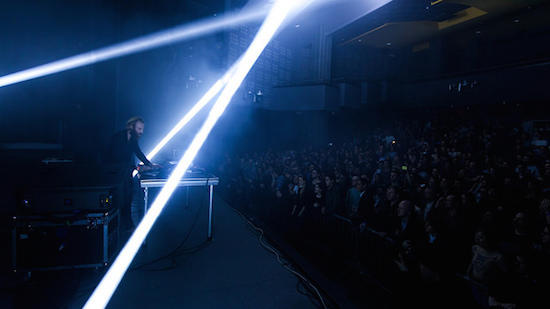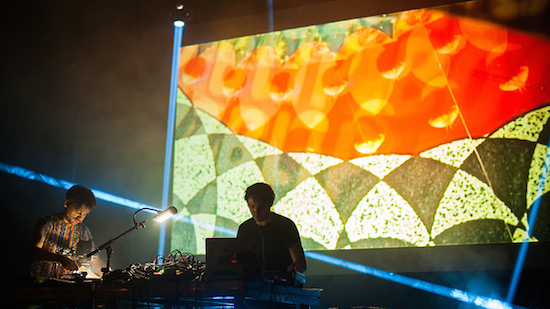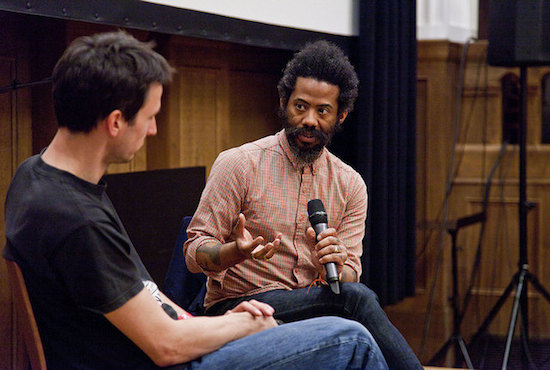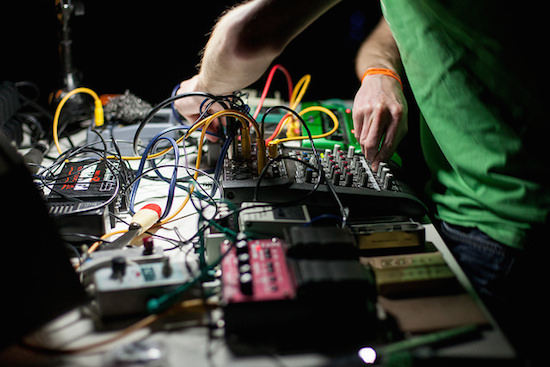This city’s time is now
Resonate is a truly unique festival. It’s partly a tech conference, partly a music festival, and partly a series of curated club nights, all taking place in disparate venues throughout the city of Belgrade. Pulling in several directions and covering a whole lot of ground over its six day programme, the overarching theme binding it all together winds up being the Serbian capital itself. For many of us in attendance, it’ll be the first time we’ve ever ventured to the city, while for several of the mostly German, American and British designers, programmers, and tech companies, the trip has become an annual tradition. What to imagine of life in the so-called Yugosphere is beyond the British mind, lying as it does between East and West, nestled between other balkan states like the forgotten kid towards the back of the classroom, still sitting on the naughty step just outside the borders of the EU.
As a showcase, Resonate festival really makes the case for Belgrade as an international cultural centre to be reckoned with. Everything’s cheap, and large venue space is plentiful, and by the very nature of a city that’s been demolished through war dozens of times throughout history, it is a patchwork of cultures, styles, and ways of life. It’s as if the Danube literally pulls together the sporadic cultures that its waters take in on their 3,000km journey to the Black Sea – from the Ukraine and Romania, to Germany and Austria. The modern age in Europe is undoubtedly defined by the existence European Union, but Serbia’s absence from it is perhaps even more defining for those on the ground here. Slovenian philospher (born when it was still in Yugoslavia) Slavoj Žižek addressed the EU’s approach to multiculturalism in a typcially animated Guardian article back in 2011 – just when the current endemic wave of sweaty idiots pedalling anti-immigrant sentiment was just finding its feet.
South Africa has now erupted into xenophobic violence, and the Mediterranean is shamefully filled with the drowned bodies of those desperately fleeing unsafe warzones. Belgrade is hardly on the brink of collapse – in fact life here seems truly beautiful – but the scars of recent conflicts still itch. The government’s refusal to accept Kosovan autonomy continue to isolate Serbia and disallow it entry into the EU, leading to third world pay packets for many Serbs, and the only way to succeed, to emigrate. The Yugoslav Ministry of Defence and several other building are still starkly bombed out right in the centre of the city – empty husks of buildings left unrepaired since Tony Blair and NATO bombed them in 1999.
Times are a-changing though. Purportedly the Trump Organisation are looking to replace the shell of the Yugoslav Ministry of Defence with a massive eyesore of a hotel. To boot, Tony Blair’s in fact now an occasional advisor for the Serbian government. There’s even a project to completely rebuild large parts of Belgrade using a blueprint left over from when Dubai became the world’s tallest (and most boring) city – the plans are plastered all over main train station in Belgrade (though it looks more like a threat than a proud exhibition to me). It seems that malevolent capitalist propaganda has regrettably won, and then some. Resonate is a voice of reason, and its vision of the city is a far superior one, littering the centre of Belgrade with futurist discourse in ageing lecture halls, experimental music in recycled factory spaces, and cavernous clubs that make a night out in Berlin look like a trip to Flares. The demonic hegemonic claws of white-Christian Western sameness rear their ugly high-rise heads once again, and the ancient stone streets of Belgrade seem doomed to crumble beneath photocopied towers of glass and metal. Ugh. This time, let’s do things a little differently for once shall we?

"Audio-visual performance" can actually mean something
In the past the words ‘audio-visual performance’ next to a band name on a bill have for the most part signified little more than a slightly trippy projection behind a band. That’s about it. As always though, technology just can’t stop moving forward, and tools like the visual synth, and other live visual gadgets and software, beef up several performances over the week. Le Révélateur – the Montreal-based project of musician Roger Tellier-Craig (formerly of Fly Pan Am, Set Fire To Flames and GY!BE amongst others) and visual artist Sabrina Ratté – open up Tuesday night in newly reopened gig space, Drugstore. The old venue (which was quite literally underground) got raided by the police and subsequently shut down, so finding the new space is something of a marathon task, particularly for a newbie alone in the city for only a few hours. I spend the best part of two hours wandering as dusk falls, bothering countless incredibly friendly natives for directions, and eventually make it into the long hall of the Drugstore just in time for Le Révélateur.
They’ve knocked up a carpeted floor for Resonators to sit on, which fits the evening’s programme of simmering music amply, so I join the punters cross-legged on the shag. Ratté’s visuals yank you right into the screen, like Jeff Bridges beaming into that computer from Tron, and we find ourselves in digital dreamworld of geometric shapes and bright neon colours, criss-crossing, mutating and pulsating with a logic all their own. Tellier-Craig’s music is equally as daunting. Waves of synthetic tones vibrate and shower from the PA, cycling through gentle melodic themes organically. Deeply submerged rhythms find their way into the set, and Ratté’s visuals respond in kind, flashing and strobing accordingly. It’s an odd sensation, but I actually find myself nodding along with pictures rather than music. It’s an utterly engaging aesthetic statement, and it takes a few minutes to get used to the world of flesh and blood again when the set is over.
Robert Aiki Aubrey Lowe – aka Lichens – has been touring the world with his modular synth setup for years now, performing monolithic improvisations for synth and voice countless times. This evening sees him in an edgy mood, quickly building bruising slow beats into the mix of drones and ghostly layered falsetto, responding to the spacious Drugstore with aggression. Lowe is silhouetted by the blank white screen behind him, then about halfway through the improvisation he fires up his own video synth (for its maiden voyage I later learn from the man). Every giant beat is met with its own pulsating colourful shape – a square, a circle, a triangle – shrinking each time the drum hits. The mood shifts from anger to beauty as Lowe introduces plucked string sounds, and by the finale the room is in reverent quiet as the beat disappears over the horizon, melting into a distant heartbeat. At its logical end, Lowe bathes the room in an earsplitting wash of noise, and we all applaud. It’s intensely minimal, even by Lowe’s normally pretty damn minimal standards, and the added colour of a single slowly pulsating shape behind him adds to the drawn out hypnosis.
Sculpture are the duo of Dan Hayhurst and Reuben Sutherland (recently interviewed on the Quietus by John Doran), and they take a more hands on approach. On the Wednesday I find them in an upstairs room in the Kinoteka (well, Belgrade’s cinema museum) running a day-long workshop, surrounded by reams and reams of cassette tape yanked from its casing, sitting at a table strewn with Sutherland’s unique zoetrope prints. Hayhurst’s literally chopping up random bits of found cassette tape into loops on the spot (we’re talking scissors and sellotape here), while Sutherland’s helping festival goers to make their own animations on a TV screen using his zoetrope turntable method. A handicam is pointing down at a turntable, coming straight out on to a screen a few metres away. At first look, each print resembles a spiralling psychedelic pattern, but when placed on the turntable (and played at the correct speed!) the pattern reveals itself on the TV as a trippy fluid animation. The duo are an incredible mix of analogue and digital methods, and the effect is visible on my moronic beaming face as Sutherland lets me have a go, and the picture on the screen gets going. Later that night we catch their show in full swing, and Hayhurst’s incredible music – the sort of bubbly old-school electronics one would expect to come from the lab of a mad scientist – bounces melodies and decaying tape loops with lovable, syncopated rhythmic intensity. It teams up with the vivid colours and brain melting animations projected behind, and the effect is spellbinding, energising, even danceable. And most importantly it’s definitely greater than the sum of its parts. This is the way audiovisual collaboration was always meant to be.

Live electronic music is still struggling through puberty, it seems
Over the course of the week in Belgrade, Resonate hosted three staunchly different types of electronic music gig. We had your ‘typical’ rock-style stage show, where the likes of Ben Frost, Machinefabriek and Fennesz played to an auditorium from a stage. We had the more intimate club night in ‘The Tube’ – a futuristic Belgrade club apparently styled after the front-cover of Kraftwerk’s Radio-Activity with additional influences from your friendly local laser quest. Here we got killer sets from the likes of Andy Stott and Belgradian producer, Jan Nemeček (who also helped curate the festival), both barely visible from deep within the crowd, aiming directly for our ears through a powerful, frankly flawless sound system. Finally there were what shall here onward be referred to as the ‘truly epic club nights’, held at dauntingly massive warehouse spaces towards the banks of the River Sava. These housed cinematic club sets from the likes of Machinedrum, Simian Mobile Disco and SOPHIE.
Ben Frost’s set sees him playing material from his recent Aurora album, this time however going fully solo rather than playing alongside two drummers as has been the norm on recent tours. The room is flooded with fog, and from the get go the lighting guy’s going nuts, blasting shafts of light in every possible direction while Frosty hits some very serious poses to go with the very serious music. It’s a truly dramatic set, building from crescendo to crescendo, and the energy in the room is potent. Anybody who’s heard Aurora understands the inherent apocalyptic drama in this music, as veiled melodies battle their way through hazy fuzzy noises and pounding heartbeats, which become almost unbearably loud at several of the climaxes. Frost constantly pushing and prodding an array of samplers on a table, occasionally turning to his guitar to create extra sounds. He also reaches back through his own catalogue a bit, seemingly plundering source material from his By The Throat album, blasting an ear splitting loud wolf roar into the room, lights still creating pandemonium in all directions.
Later, Rutger Zuydervelt – aka the Netherland’s prolific minimal master of drones, Machinefabriek – presents us with the polar opposite performance. He sits behind a desk, nobly lit with an unblinking single light, and proceeds to craft gentle, almost imperceptibly quiet improvisations. Strands of sound interlock into pseudo-music, static from the speakers sounds like the crumpling of paper in the room, and rhythms seemingly dissipate before being fully realised. It lives up to the artist’s usual brand of intensely unknowable music, prodding certain emotions you can’t quite pin down. "Oh, this is nice," you think to yourself, before all of a sudden proceedings take an about turn and Machinefabriek starts squelching strange unpleasant fuzz at you. Going from the lights and big show of Ben Frost to the often quiet, classroom like demonstration by Machinefabriek is the experimental electronic equivalent of following a Pink Floyd stadium show with a trip to Longstanton Spice Museum. While one invariably finds sheer brutal honesty and truth in Machinefabriek’s compelling minimal performance, the sheer bombast of Ben Frost’s really makes a statement – besides who doesn’t like a properly exciting performance? Either way, it’s still mostly two white dudes standing behind a table pushing buttons.

The future is now
Machinedrum really acts like the archetypal white bellend, trucker capping his way through some painful hype moves – it’s a bit like watching your brother’s stupid mate do a poor Kanye West impression. But his set rolls through a great series of footwork jams, and it’s basically impossible to dislike the show – the man is clearly in love with Detroit, and he really knows his stuff. Simian Mobile Disco offer a vastly different approach to anybody at the festival, essentially using the same sort of old (and large) analogue gear the likes of Tangerine Dream would have used. Many in attendance are sound and video designers, and generally techy geeks, so the sight of Simian Mobile Disco triggers bountiful conversation about which bit of gear does what. They even seem to accidentally trip over and hit the big red ‘off’ button, plunging the room into temporary quiet, but nobody cares. As very clever industry people, we all "understand the dangers" of using old gear, and we dance even harder when they get going again moments later, grinding arpeggios over live drum machine grooves. Sophie’s set gets madly well received by the Serbian audience, which fully makes sense. SOPHIE and the closely associated PC Music gang are making what could be arguably the perfect global pop music. Happy, high energy, generous with melody and cheesy synth chords, and in its own strange way, anthemic to boot. How those chipmunk vocals don’t jar a bit more I’ll never understand – but all in attendance are left beaming, myself included.
Fennesz seems to play almost exclusively from his most recent album Bécs, for the most part originating the music on a laptop screen we can’t see. There are several key moments though, where the man turns to his guitar, strumming and picking out some of Bécs‘ momentous melodic themes, before disintegrating them into slow moving clouds that dance around the venue. Throughout, visual artist Lillevan is utilising god knows what to craft intensely colourful grainy visuals, occasionally perceptibly composed of layer upon layer of worn, yet colourful imagery. It all comes across like the rather classically psychedelic rainbow cousin of E. Elias Merhige’s harshly monochrome Begotten, but most vitally, the entire thing engulfs the crowd, and feels truly ‘live’. I conclude that there is of course no single approach to make computer-based music into a "proper gig" (however you want to define that) and we’re of course better off in a world containing all these differing approaches. Having said that, I’m not sure how much I’d be up for seeing live coding. Not without a crazy light show anyway.
I like to be confused
My favourite musical discovery of the weekend is noisemaker, Vladimir Lenhart, aka Lenhart Tapes. Based in Serbia’s second city of Novi Sad, Lenhart seems to exclusively use tape players to make his music. He stands behind a table with four old portable cassette players on it, and bursts into action, slamming cassettes in to them, bashing play and stop buttons, and generally looking like he’s about to angrily smash everything in sight. Each ‘song’ basically consists of a looped 4/4 industrial rhythm (presumably on a homemade cassette of his own), while randomly chosen middle-eastern chants and other madness bump and grind deafeningly on top. People actually try to dance! Saxophones blast out of one cassette, while freeform white noises spills out the other. Lenhart grabs a walkman, yanks it open and starts smudging and scraping the tape itself, twisting the Walkmen’s innards to craft new strange sounds. There’s other sections that see him strangely manipulating the fast-forward function to locust-like effect. It’s a grand, shocking and utterly confusing bit of culture jamming – like the city of Belgrade herself. I later visit the Ethnographic museum just over the road from the Kinoteka where much of Resonate is held, and peruse clothing, artefacts and model homes from all corners of Serbia, going back hundreds of years. The styles are invariably a crazy mix of East and West and North and South. One costume seems to compromise lederhosen and a fez.
Resonate festival is an eye opener, and undoubtedly one of the best festivals in Europe – it triggers discourse and dance moves in equal measure (not many festivals can claim that). The city of Belgrade is a real city of the future, and its fate reflects the fate of European society. The question of what comprises art, what comprises a performance, even what comprises good architecture are all really us asking what will make a good future. Well, I really hope the future looks like this.
<div class="fb-comments" data-href="http://thequietus.com/articles/17768-festival-report-resonate-review” data-width="550">


